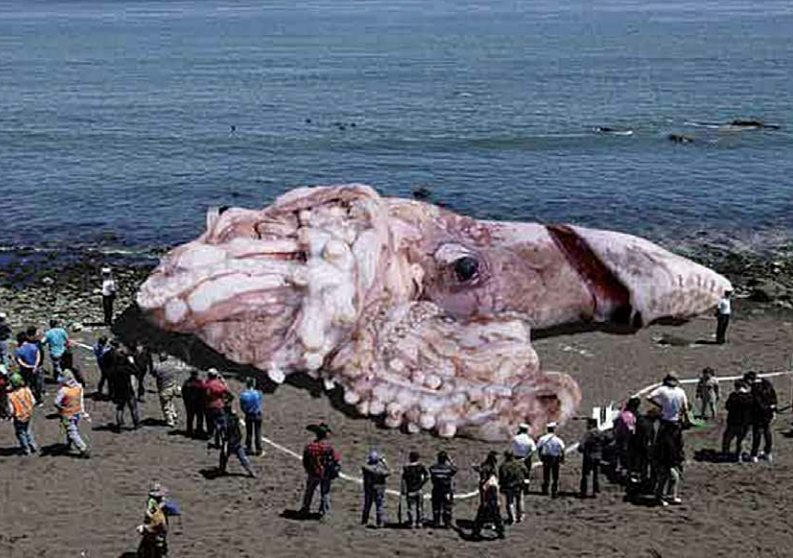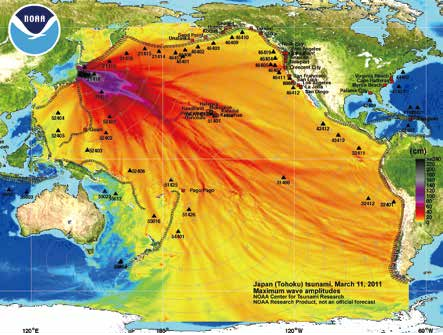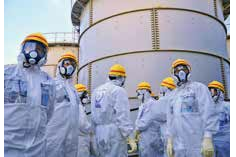Issue:
Amidst the serious radiation issues that still demand a close watch are hyperbolic rumors whose provenance have scientists scratching their heads

THIRD ANNIVERSARY OF 3/11
If you’re living in Japan, you’re bound to have been scolded by friends or loved ones overseas for stubbornly ignoring the dangers of radiation leaking from the Fukushima Daiichi Nuclear Power Plant, wrecked by the Tohoku earthquake and tsunami three years ago this month. After all, it’s hard to tell fact from fiction when it comes to nuclear radiation and its impact on health and the environment, especially when there’s such well deserved public distrust in Tepco, the Tokyo Electric Power Company.
While the utility’s repeated blunders in its efforts to contain the crisis don’t inspire confidence, it’s also easy to forget that there have been no deaths from the release of radiation. According to the World Health Organization, those in the worst-affected areas face a slightly higher risk of developing certain cancers.
People who don’t believe what officials say about radiation levels can ask Safecast, a “pro-data” NPO committed to gathering radiation readings through detectors and volunteers. It has collected over 14 million data points through an array of 800 sensors, and has indeed found higher radiation levels close to the reactors. However, both Safecast and government readings have shown radiation levels near the plant falling by about 40 percent per year.
“The reality is that there are some very contaminated areas in Fukushima which are already closed to habitation and will need to be closed for decades,” says Azby Brown, a Safecast researcher. “The real problems the disaster has caused are tremendous and challenging, and require serious attention. It's a shame time and energy has to be wasted playing ‘whack-a-mole’ with hoaxes and misunderstandings. Oddly, most of these recent stories seem to originate in the U.S., where mistrust of government in some circles has made people vulnerable to all sorts of fantastic and implausible conspiracy theories.”
Here’s a selection of the most egregious “moles” that have burrowed their way through the mediasphere and deserve a good whacking.
THE ARNIE GUNDERSEN HIT PARADE
Whack-o-meter: 8A nuclear engineer in the 1970s turned whistleblower, Arnie Gundersen is a one-man Fukushima alarm industry. His resume lists pages and pages of public testimony to august bodies on nuclear issues and he commands wide attention in the public sector and news media. Leaving aside his credentials as “chief engineer” of the NPO Fairewinds Energy Education, his statements have undoubtedly fueled anxiety about the scale of the disaster and its impact on health.
l “Fukushima is the biggest industrial catastrophe in the history of mankind” Gundersen told Al Jazeera in June 2011. Tell that to the families of the 4,000 to 20,000 people killed by highly toxic methyl isocyanate gas that leaked from a Union Carbide pesticide plant in Bhopal, India 30 years ago.
l “The amount of radiation released was clearly as much as Chernobyl, but most of it headed out to sea” Gundersen told Democracy Now! in 2012. Numerous estimates disagree, putting the Fukushima radiation at about one-fifth to one-tenth that spewed by the Chernobyl plant. A 2011 study in Atmospheric Chemistry and Physics estimated that the actual amount of cesium 137 released was “roughly twice the official government figure, and half the release from Chernobyl,” Nature reported.
This photoshopped image of a “giant squid” quickly went viral. While this may be a quite obvious joke, other rumors are misinformation that is often taken for truth.
l “My estimate is that over the next 30 years we’re going to see about a million cancers as a result of this” This staggering assertion seems to be based on little more than Gundersen’s whimsy. Stanford University researchers have estimated in Energy and Environmental Science that the disaster could eventually cause about 130 deaths from radiation and 180 cases of cancer. That is a drop in the bucket compared to annual cancer deaths in Japan and less than one-third of the roughly 600 deaths caused by the stress of evacuating people from around the Fukushima plant area.
FUKUSHIMA MADE CALIFORNIA BEACHES RADIOACTIVE
Whack-o-meter: 6If you believe everything you see on YouTube, you'll want to stay well away from Half Moon Bay near San Francisco. A video posted in December 2013 shows a man with a geiger counter approaching the surfing spot as the reading goes from about 40 to over 150, triggering an alarm. “It's consistently over 100,” he says, adding that he has had several such results recently. “The readings are solid.” The video has been viewed more than 750,000 times and sparked fears that Fukushima radiation has polluted the Golden State's golden shores.
Naturally occurring radioactive material (NORM) at beaches has been known for decades. It can sometimes be traced to soil erosion and the presence of thorium-rich granite. “Recent tests show that elevated levels of radiation at Half Moon Bay are due to naturally occurring materials and not radioactivity associated with the Fukushima incident,” said Wendy Hopkins, spokes-woman of the California Department of Public Health. “There is no public health risk at California beaches due to radioactivity related to events at Fukushima.”
Dan Sythe, CEO of radiation monitor maker IMI International Medcom tested soil at the beach and found its naturally occurring radiation is likely associated with dark sand below the high-tide level. “The radiation level is elevated,” he wrote on Geiger Counter Bulletin, “but roughly equivalent to some granite counter top material from Brazil.”
THE PACIFIC IS A RADIOACTIVE CONVEYOR BELT
Whack-o-meter: 8If you’ve been living under a rock, or in a nuclear fallout shelter, you may have missed the many maps circulating on the Internet showing brightly colored plumes of radiation exploding eastward from Fukushima over the Pacific Ocean. Just Google “Pacific radiation map” and you’ll find many examples, but one of the worst offenders is an orange-yellow Pacific shot through with veins of crimson. The entire ocean looks like a nuclear wasteland.
If the fact that the supposed radiation seems to stop when it hits land seems a little bizarre to you, your skepticism is well founded. The image is actually a National Oceanic and Atmospheric Administration (NOAA) map showing the height of waves associated with the March 2011 tsunami. NOAA produced at least two such plots after the historic quake, with the estimated maximum height of the waves hitting 240 cm.

THE OCEAN IS A DEAD ZONE
Whack-o-meter: 9“The Pacific Ocean appears to be dying,” NaturalNews observed in January, “a phenomenon that the data suggests is a direct consequence of nuclear fallout from Fukushima.” Just where was this data coming from? A 2013 study of deep-sea creatures by the Monterey Bay Aquarium Research Institute. Natural News put its spin on the paper this way: “Though the researchers involved with the work have been reluctant to pin Fukushima as a potential cause National Geographic, which covered the study recently, did not even mention Fukushima the timing of the discovery suggests that Fukushima is, perhaps, the cause.”
You can’t argue with ironclad logic like that. It sounds better with some numbers, of course, so NaturalNews decided that 98 percent of the sea floor off California is covered with dead animals, up from 1 percent before Fukushima. The Monterey Aquarium study actually indicated that an unusual abundance of gelatinous creatures known as salps ended up carpeting the abyssal floor after dying. Furthermore, scientists found that there were actually more algae and salps in California waters in 2011 and 2012 than in the previous 20 years. As the institute pointed out in a press release debunking the report, “There is no indication that any of the events documented in this study were associated with the Fukushima nuclear accident.”
Emails accompanying this widely circulated map often claim that it shows the spread of radiation from Fukushima. It is actually from the U.S. National Oceanic and Atmospheric Administration, and shows the tsunami wave amplitude.
WEST COAST FISH ARE RADIOACTIVE
Whack-o-meter: 7Fears about radiation reaching the North American West Coast have focused on reports that fish are becoming extremely contaminated. Doubtless this has been fueled by the real news that some fish caught off Tohoku are unfit for human consumption. But the miles and miles of ocean between that region and the West Coast ensures the effects are limited, as Ken Buesseler of the Woods Hole Oceanographic Institution writes: “These contaminated fish are not being sold internally in Japan or exported. Because of the dilution that occurs even a short distance from Fukushima, we do not have a concern about the levels of cesium and other radionuclides in fish off the West Coast of the U.S.”
While cesium has indeed been discovered in Pacific bluefin tuna (PBFT), a find that was reported by over 1,000 newspapers worldwide, a study published in the Proceedings of the National Academy of Sciences showed that a standard serving of such fish would expose someone to radiation equivalent to that in about one-twentieth of a banana. “Although uncertainties remain regarding the assessment of cancer risk at low doses of ionizing radiation to humans, the dose received from PBFT consumption by subsistence fishermen can be estimated to result in two additional fatal cancer cases per 10,000,000 similarly exposed people,” the study states.
USED FUEL RODS WILL IGNITE IF EXPOSED TO AIR
Whack-o-meter: 7.5In November, Tepco began the delicate task of removing 1,534 nuclear fuel rods from a storage pool at the Fukushima Daiichi plant’s No. 4 reactor building. The pool has been reinforced since the March 11, 2011 disaster, but Tepco wants the rods in a safer location and the job is expected to take until the end of 2014 at least.
Fears have focused on the possibility of another quake striking the building, which could cause more cracks in the pool and drain the water from it. Various media have painted alarming scenarios of what will happen if the rods are exposed to air. “That would allow the zirconium alloy cladding to ignite and release radioactive material into the air,” said the Telegraph. But if a YouTube demonstration by UC Berkeley nuclear engineers is anything to judge by, zirconium alloy cladding does not ignite when exposed to air, or even a blowtorch. They heated a piece of zirconium to 2,000ºC without sparking a fire. (Zirconium powder, however, is flammable.)
A FUEL ROD DISASTER WILL DESTROY JAPAN AND THE WEST COAST
Whack-o-meter: 9
David Suzuki is a household name in Canada. The scientist, broadcaster, and member of the Order of Canada is known for his long-running CBC documentary show “The Nature of Things,” and has been championing the cause of wildlife and the natural world for decades. So people took note when he warned last fall that a major quake during the fuel rod extraction process at Fukushima would precipitate a nuclear holocaust. He went on to claim there was a greater than 95 percent probability of such a quake in the next three years. terrifying, I don’t know what is.”
There is no scientific evidence to support that wild scenario. David Measday, a professor emeritus of nuclear physics at the University of British Columbia, dismissed it as “ridiculous” and “totally impossible.” Suzuki recently said he regrets what he termed an “off-the-cuff” remark, but still fears a “potential widespread disaster” from a second quake or tsunami hitting what’s left of the Fukushima plant.
FUKUSHIMA IS KILLING AMERICAN BABIES, ADULTS AND . . . BALD EAGLES
Whack-o-meter: 10
In 2011, physician Janette Sherman and epidemiologist Joseph Mangano reported in Counterpunch that in the 10 weeks to the end of May that year, there was a 35 percent increase in baby deaths in eight cities in the Northwest compared to the four weeks to March 19, 2011. The increase “is statistically significant,” they wrote, pointing out that it coincided with the Fukushima meltdown. The article is premised on analysis of Centers for Disease Control and Prevention data, but an analysis by Michael Moyer of Scientific American shows how the CDC numbers were cherry-picked to suit the authors’ premise. If data from the beginning of 2011 are included (and not just the four weeks to March 19), there is no change in baby deaths.
The duo, part of an anti-nuclear group called Radiation and Public Health Project, returned in 2012 with another report, this time in the International Journal of Health Services, suggesting as many as 14,000 Americans had been killed by Japanese radiation. They arrived at this shocking figure again via creative statistics: The tally of CDC deaths for 122 cities increased 4.46 percent in the 14 weeks after the fallout from 2010 levels, and projecting that increase yields a nationwide total of about 14,000 people. “The analysis assumes that the plume arrived on U.S. shores, spread everywhere, instantly, and started killing people immediately,” Moyer writes. “The publication of such sloppy, agenda-driven work is a shame.”
Meanwhile, dozens of bald eagles have died mysterious deaths in Utah. They have been found with paralysis, seizures and tremors. Officials at the Wildlife Rehabilitation Center of Northern Utah were baffled, and told the L.A. Times they weren’t ruling anything out, including Fukushima radiation. This predictably spawned a series of articles linking the two. Tests ultimately revealed that West Nile virus in grebes the eagles fed on was responsible.
SQUID GROWS TO 160 FEET, COMES ASHORE IN CALIFORNIA
Whack-o-meter: 11
This is really too daft to mention, but points for creativity go to satirical website The Lightly Braised Turnip for reporting that a 160-foot squid had washed up on a beach in Santa Monica, California. Over 1 million Facebook users liked the farce, especially its fake photo of people gawping over the housesized cephalopod, and naturally it rampaged through social media like a kaiju in heat. The article quoted experts who said the creature came from “waters near the Fukushima Daiichi Nuclear Power Plant in the Futaba District of Japan.” Writers at urban legends site Snopes.com actually visited the beach in question and of course no squid, giant or otherwise, was to be found. Other Fukushima mutant hoaxes have included vegetables, dogs, and rabbits.

FUKUSHIMA CANARDS CIRCULATING IN the media detract from the ongoing cost of the triple meltdown at the plant and the need for continued public scrutiny and vigilance. There are legitimate concerns about the potential danger from an accident involving the transfer of fuel rods from Reactor 4, not to mention the fact that no one really knows yet the condition of the reactor cores that have melted down.
This spring also marks the third anniversary for thousands of Fukushima Prefecture evacuees who lost their homes. About one-third of 160,000 people who fled remain in temporary housing, stuck in legal limbo as the government tries to decide if it can live up to its cleanup promises. A ray of light was seen in February, however, when for the first time an evacuation order was lifted for a restricted area: residents of part of Tamura will be able to return home April 1.
Meanwhile, the death toll in Fukushima from stress and other conditions related to the disaster recently hit 1,656, topping the 1,607 killed in the prefecture by the tsunami and quake. "People have gone through dramatic changes of their environment,” a prefectural health official told AFP. “As a result, people who would not have died are dying.”
Another ongoing concern is possible links between radiation and thyroid cancer, especially among children. Eight more kids were found to have thyroid cancer in February, though health officials ruled out radiation from the plant as a cause. As of the end of 2013, there were 33 people under 18 confirmed with the disease, up from 25 three months earlier. The findings are worrisome but on a far different scale than those from the Chernobyl disaster, in which more than 6,000 children and adolescents were diagnosed with thyroid cancer, according to the U.N. Scientific Committee on the Effects of Atomic Radiation. A team from the Health, Labor and Welfare Ministry is also checking 1,972 workers from the plant who helped contain the disaster in the initial stages and were exposed to radiation doses over 100 millisieverts.
Tim Hornyak is Tokyo correspondent for IDG News Service. A former CNET News contributor, he is the author of Loving the Machine: The Art and Science of Japanese Robots and co-author of several Lonely Planet travel guidebooks.

